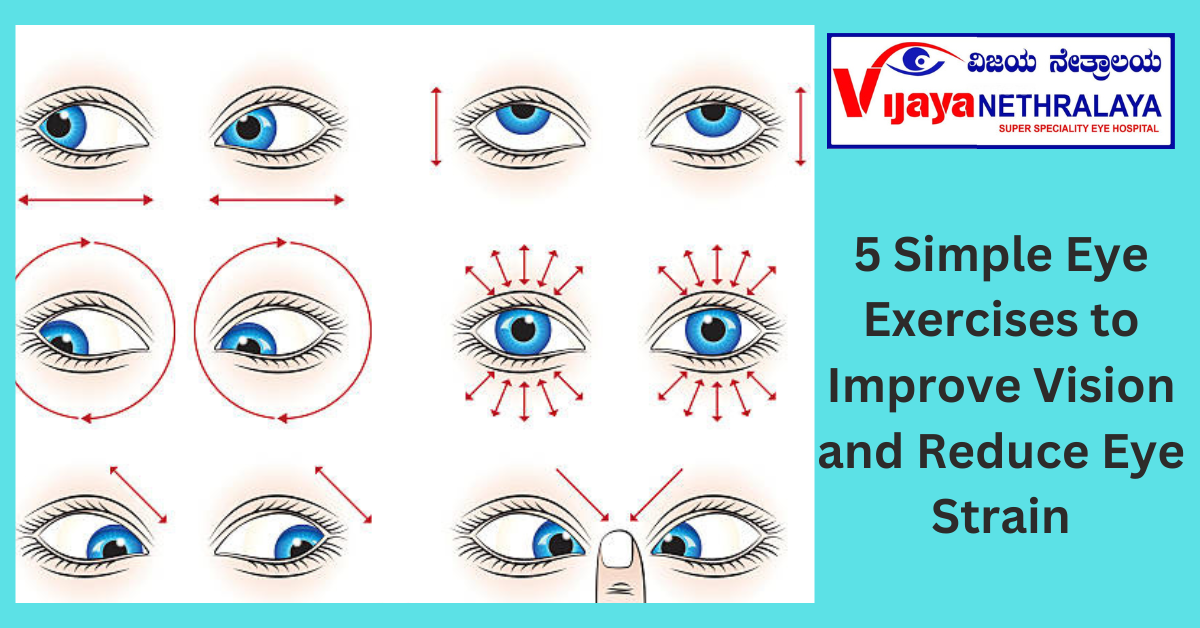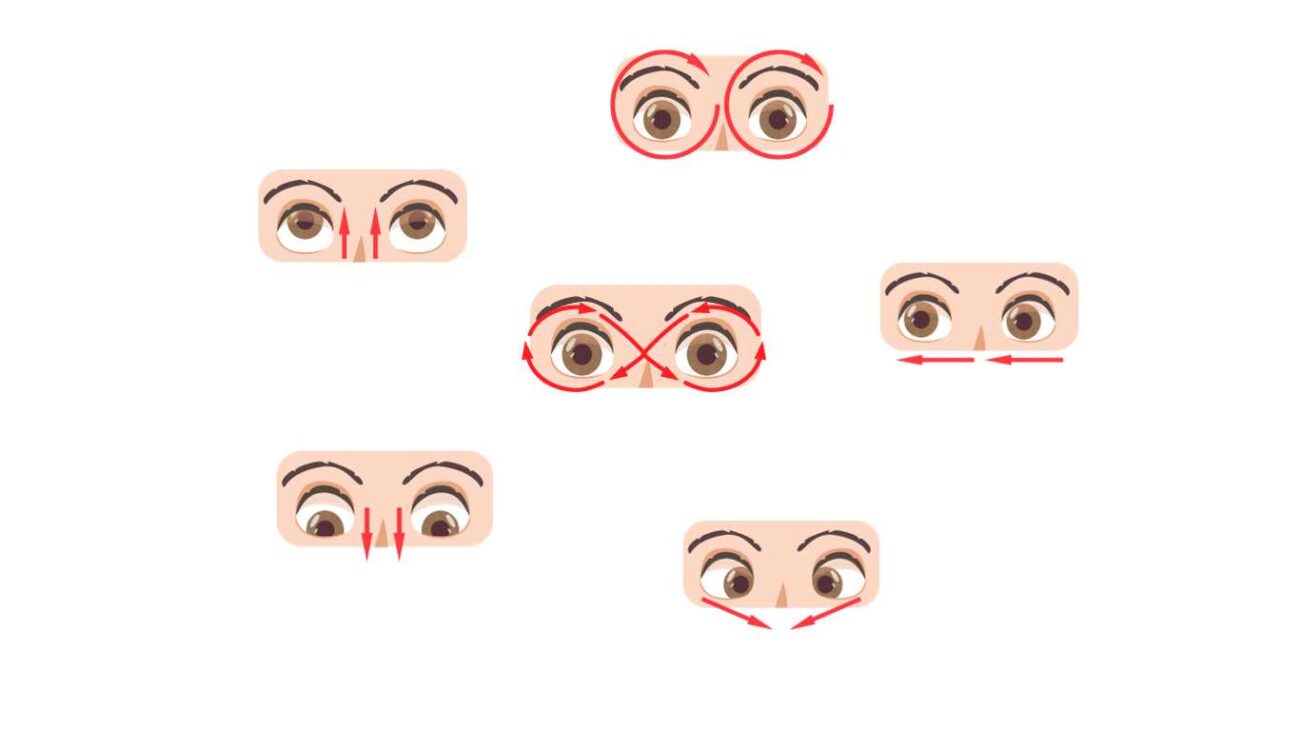Introduction:
In today’s digital age, we spend more time than ever staring at screens, which can lead to eye strain, fatigue, and even vision problems. However, there are simple eye exercises that you can do at home to improve vision and reduce eye strain. These exercises can help strengthen eye muscles, promote healthy vision, and alleviate common eye problems such as dry eyes, blurred vision, and headaches. In this article, we will discuss 5 simple eye exercises that you can incorporate into your daily routine to promote healthy eyes and reduce eye strain.
Importance of eye health and eye exercise:
Your eyes are one of the most important sensory organs in your body. They help you see the world around you and enable you to do things like reading, driving, and watching movies. However, like any other part of your body, your eyes need proper care and attention to function optimally.
One way to take care of your eyes is through regular eye exercises. These exercises can help improve eye health, reduce eye strain and fatigue, and prevent or alleviate common eye problems like nearsightedness, farsightedness, and astigmatism.
Eye exercises work by stimulating the muscles around your eyes, which can improve blood circulation and promote the flow of nutrients to your eyes. They can also help you develop better eye coordination, focus, and concentration. In addition to eye exercises, other healthy habits like getting enough sleep, eating a balanced diet rich in vitamins and minerals, and taking regular breaks from screens can also promote good eye health.
How Eye Exercises Can Help:
Eye exercises can help in a variety of ways. Here are some of the benefits:
- Reduce eye strain and fatigue: If you spend a lot of time looking at screens or doing close-up work, your eyes can get tired and strained. Eye exercises can help relieve this strain and reduce fatigue for your eye exercises for clear vision.
- Improve focus and concentration: Eye exercises can help improve your ability to focus and concentrate on visual tasks, such as reading, driving, and playing sports.
- Enhance eye coordination: Eye exercises can help improve the coordination between your eyes, which can help with depth perception and other visual skills.
- Reduce the risk of eye problems: Some eye exercises can help prevent or reduce the risk of common eye problems, such as nearsightedness, farsightedness, and astigmatism.
- Improve visual acuity: Certain eye exercises can help improve your visual acuity, which is the sharpness also eye exercises for healthy vision.
- Increase blood flow to the eyes: Eye exercises can help increase blood flow to the eyes, which can provide essential nutrients and oxygen to the eye muscles and tissues.
Overall, eye exercises can be a simple and effective way to promote good eye health and maintain clear vision. However, it’s important to note that eye exercises should not replace regular eye exams or medical treatment for any underlying eye Eye exercises for eye health.
5 Basic Eye Exercises for Relaxation and Strengthening:
Certainly, here are some basic eye exercises for relaxation and strengthening:

Palming:
Rub your hands together to warm them up, then place your palms over your eyes, with your fingers overlapping on your forehead. Close your eyes and breathe deeply for a few minutes, imagining that your eyes are resting and relaxing. This exercise can help reduce eye strain and promote relaxation.
Blinking:
Blink your eyes rapidly for about 30 seconds, then close your eyes and relax for a few seconds. Repeat this a few times. Blinking exercises can help lubricate your eyes and reduce dryness and irritation it will help to eyesight improvement .
Eye rotations:
Sit up straight and look straight ahead. Slowly rotate your eyes in a circle, first clockwise, then counterclockwise. Repeat this a few times, then blink your eyes and rest for a few seconds. Eye rotations can help improve eye coordination and reduce eye strain.
Focus shift:
Hold your finger or a pen about 6 inches away from your face. Focus on the object, then slowly shift your focus to a distant object in the room. Repeat this a few times, then rest your eyes for a few seconds. Focus shifts can help improve your ability to focus and reduce eye strain.
Near and far focusing:
Hold a book or other object close to your face, then slowly move it away, focusing on it as you do so. Repeat this a few times, then rest your eyes for a few seconds. Near and far focusing exercises can help improve your ability to adjust your focus between near and far distances.
These basic eye exercises can be done regularly to promote relaxation and strengthen the muscles around your eyes. However, if you experience any discomfort or pain during these exercises, stop immediately and consult with an eye doctor or optometrist.
Benefits of eye exercises:
These are a set of simple activities designed to strengthen and improve the function of the eye muscles. These exercises can be performed by anyone, regardless of age or visual ability. Here are some potential benefits of eye exercises:
- Improved vision: Eye exercises can help improve vision by strengthening the muscles that control eye movement and focus. This can lead to better visual acuity and reduced eye strain this will help to eyesight improvement .
- Reduced eye fatigue: Many people spend long hours looking at computer screens or other digital devices, which can cause eye fatigue and strain. Eye exercises can help reduce these symptoms by promoting the relaxation of the eye muscles.
- Better eye-hand coordination: Eye exercises can also improve hand-eye coordination, which is important for many activities such as playing sports, driving, and typing.
- Prevention of eye diseases: Some eye exercises can help prevent or delay the onset of age-related eye diseases such as macular degeneration and cataracts.
- Reduced stress: Eye exercises that involve relaxation techniques and this Eye exercises for clear vision can help reduce stress and promote overall well-being.
Overall, incorporating eye exercises into your daily routine can help improve your vision and reduce eye strain and fatigue, leading to better overall eye health.
How to improve eyesight naturally at home:
There are several natural ways to improve eyesight at home. Here are some tips:
- Eat a healthy diet: A diet rich in nutrients such as vitamins A, C, and E, as well as omega-3 fatty acids, can help improve eyesight. Consuming a generous amount of fruits, vegetables, and fish can be beneficial for maintaining a healthy diet. Practice good eye hygiene: Clean your eyes regularly to remove dust and other irritants that may cause infections not touch your eyes with unclean hands.
- Take regular breaks from screen time: Long screen time can strain your eyes. Make it a habit to take frequent breaks to divert your gaze from the screen and shift your focus onto other things.
- Exercise your eyes: Ensure that you obtain adequate sleep each night as sleep deprivation can lead to eye strain and fatigue. Shield your eyes from the sun’s harmful UV rays to prevent potential eye damage.
- Get enough sleep: Lack of sleep can cause eye fatigue and strain. Make sure you get enough sleep every night.
- Protect your eyes from the sun: Exposure to UV rays can damage your eyes. Wear sunglasses or a hat with a brim when you go outside.
- Quit smoking: Smoking can increase the risk of age-related eye diseases such as macular degeneration and cataracts.
By incorporating these tips into your daily routine, you can improve your eyesight naturally and maintain good eye health. However, if you experience any persistent vision problems, it is important to consult an eye doctor for a proper diagnosis and treatment.
Eye Exercise Plan: Tips and Strategies:
Here are some tips and strategies to create an effective eye exercise plan:
- Consult with an eye doctor: Before starting any eye exercises, it is essential to consult with an eye doctor to ensure that the exercises are safe and appropriate for your individual needs.
- Start slowly: Start with simple exercises and gradually increase the intensity and duration as your eyes become stronger.
- Incorporate variety: Incorporate a variety of exercises that target different eye muscles and visual skills. This can help prevent boredom and ensure that all areas of your vision are being addressed.
- Set a regular schedule: Set a regular schedule for your eye exercises and try to stick to it. Consistency is key when it comes to improving eye health.
- Take breaks: Take breaks between exercises and throughout the day to rest your eyes and prevent eye strain.
- Combine with other healthy habits: Combining eye exercises with other healthy habits such as a balanced diet, good sleep habits, and regular exercise can further improve eye health.
- Be patient: Improving eye health takes time and patience. Don’t expect to see immediate results, but rather commit to a consistent routine over time.
By following these tips and strategies, you can create an effective eye exercise plan that helps improve your vision and maintain good eye health. Remember to always listen to your body and consult with an eye doctor if you experience any persistent vision problems.
Lifestyle Changes for Healthy Eyes: Nutrition, Sleep, and Screen Time:
Certain lifestyle changes can help promote healthy eyes and reduce the risk of vision problems. Below are some recommendations for maintaining a healthy: lifestyle:Nutrition: Eating a balanced diet rich in nutrients such as vitamins A, C, and E, as well as omega-3 fatty acids, can help promote good eye health. Foods that are particularly beneficial for eye health include leafy green vegetables, citrus fruits, nuts, and oily fish.
- Sleep: Having sufficient sleep is crucial for maintaining good health, which includes taking care of your eyes. Inadequate sleep can result in dry eyes and eye strain. It is recommended to aim for at least 7-8 hours of sleep per night. Screen time: Excessive screen time can lead to eye strain and other vision problems. Follow the 20-20-20 rule, which involves taking a 20-second break every 20 minutes and looking at something 20 feet away. This can help reduce eye strain and promote good eye health.
- Exercise: Regular exercise can help improve blood flow and reduce the risk of vision problems such as glaucoma and macular degeneration.
- Quit smoking: Smoking can increase the risk of vision problems such as cataracts and macular degeneration. Quitting smoking can help reduce this risk and promote good eye health.
By incorporating these lifestyle changes into your daily routine, you can help promote good eye health and reduce the risk of vision problems. Remember to always listen to your body and consult with an eye doctor if you experience any persistent vision problems.
Eye Exercise for Kids: Keeping Their Vision Healthy:

As parents, we always want our children to grow up healthy and happy. We make sure they eat well, sleep well, and get enough exercise. But did you know that there are specific exercises that can help keep your child’s eyes healthy?
In this article, we’ll discuss the importance of eye exercises for kids and provide some simple exercises that you can do with your child to keep their vision in top shape. In today’s digital age, children are spending more time than ever before in front of screens. Whether it’s watching TV, playing video games, or using mobile devices, all these activities can strain their eyes and lead to vision problems. Eye exercises can help strengthen the muscles in the eyes, reduce eye strain, and improve visual acuity.
Eye Exercises for Kids:
Here are some easy eye exercises that you can do with your child:
1. Blinking Exercise:
Blinking is a natural way to lubricate the eyes and reduce eye strain. Encourage your child to blink their eyes rapidly for a few seconds, then close their eyes and relax for a few seconds. Repeat this exercise several times.
2. Near and Far Focusing:
This exercise helps improve the flexibility of the eye muscles. Ask your child to hold a pencil at arm’s length and focus on it. Then, ask them to focus on an object in the distance. Repeat this exercise several times.
3. Eye Rolling:
This exercise helps improve the flexibility of the eye muscles and can help reduce eye strain. Ask your child to look up and then slowly roll their eyes in a circle. Perform this exercise multiple times in both clockwise and counterclockwise directions.
4. Zooming Exercise:
This exercise helps improve visual acuity and can be done with any object. Ask your child to hold an object at arm’s length and slowly bring it closer to their eyes until it becomes blurry. Then, ask them to slowly move the object away until it becomes clear again. Repeat this exercise several times.
5. Eye Massage:
This exercise helps relax the eye muscles and improve blood flow to the eyes. Gently massage your child’s closed eyelids with your fingertips in a circular motion for a few seconds. Repeat this exercise several times.
Eye exercises with a pen:
Eye exercises with a pen are a great way to improve eye muscle strength and flexibility. Here is an exercise you can do with a pen:
- Hold a pen at arm’s length and focus on the tip of the pen.
- Slowly bring the pen closer to your face, keeping your focus on the tip.
- Stop when the pen is about 6 inches away from your face.
- Slowly move the pen away from your face, keeping your focus on the tip.
- Stop when the pen is back at arm’s length.
- Repeat the exercise several times.
This exercise can help improve your ability to focus on objects at different distances and reduce eye strain. Remember to always listen to your body and stop the exercise if you experience any discomfort or pain. Additionally, it is essential to consult with an eye doctor to determine the cause of any vision problems and develop a personalized treatment plan.
Eye exercise with or without glasses:
Whether or not to wear glasses during eye exercises depends on the individual’s vision needs. If a person has a refractive error such as nearsightedness or farsightedness, they may need to wear their glasses during the exercises to achieve optimal results.In some cases, wearing glasses during eye exercises may be beneficial, as it allows the person to see more clearly and focus better on the exercises.
On the other hand, if a person does not have a refractive error and does not need glasses for daily activities, they may not need to wear glasses during the exercises.It is important to consult with an eye doctor or vision therapist before starting any eye exercise program, as they can guide the best exercises to perform based on the individual’s needs and vision status. Additionally, an eye doctor can evaluate whether or not glasses are necessary during the exercises.
Conclusion:
In conclusion, eye exercises are a great way to reduce eye strain and improve eye health. Whether you spend long hours in front of a computer screen or simply want to maintain good eye health, incorporating eye exercises into your daily routine can have numerous benefits. By relaxing the eye muscles, increasing blood flow to the eyes, and improving focus and clarity, these exercises can help prevent eye fatigue, dryness, and discomfort. Additionally, regular eye exams, proper nutrition, and good eye hygiene practices can further support healthy eyesight.
Remember to always consult with your eye doctor before starting any new exercise regimen or making changes to your eye health routine. With proper care and attention, you can maintain good eye health and enjoy clear, comfortable vision for years to come.
Author Details:
Dr. Sushruth Appajigowda holds a prominent position as a Cornea, Cataract, Glaucoma, and LASIK Surgeon in Bangalore. He serves as the chief Cataract and Refractive surgeon at Vijaya Nethralaya Eye Hospital, Nagarbhavi Bangalore. Renowned as one of the finest LASIK surgeons nationwide, he brings with him over 12+ years of experience across multiple LASIK platforms, including ZEISS, ALCON, SCHWIND, AMO, and Bausch and Lomb. Having successfully conducted over 5000 LASIK procedures, Dr. Sushruth holds the title of a Certified Refractive Surgeon and a Fellow of the All India Collegium Of Ophthalmology. Furthermore, he stands as a distinguished speaker at various National and International Forums, using his expertise to guide you in selecting the most suitable procedure based on your health requirements.

http://vijayanethralaya.com/link-in-bio/
FAQS:
Is eye exercise safe?
Most eye exercises are safe when performed correctly and under the guidance of an eye doctor. However, it’s important to note that some exercises may not be appropriate for certain conditions, and some people may experience discomfort or pain when performing certain exercises.
It’s always best to consult with an eye doctor before starting any new exercise program to determine if it’s appropriate for your specific condition. Additionally, it’s essential to listen to your body and stop any exercise if you experience discomfort or pain.
In summary, eye exercises can be safe under a doctor’s guidance but may not suit all conditions. Always consult a professional before starting.
2. Is it possible to improve eyesight naturally?
There is some evidence to suggest that certain exercises and lifestyle changes can improve eyesight naturally, although results may vary depending on the individual.
One method that is effective for some people is eye exercises. These exercises are designed to strengthen the muscles that control the eyes and improve their flexibility. Examples of eye exercises include focusing on a distant object for a few minutes at a time, moving the eyes in different directions, and using eye massages.
3. can eyesight improve with age?
It is common for eyesight to decline with age due to various factors such as changes in the shape and flexibility of the lens, reduced pupil size, and reduced sensitivity of the retina. However, in some cases, eyesight can improve with age.
For example, some people who have been nearsighted (myopic) since childhood may experience an improvement in their vision as they age, due to changes in the shape of the eye. Additionally, people who develop cataracts, which can cause blurry vision, may experience improved vision after cataract surgery.
5. Are eye exercises safe for kids? How Often Should Kids Do Eye Exercises?
Yes, eye exercises are safe for kids.
It’s important to note that eye exercises should not replace a comprehensive eye exam by an eye doctor. However, incorporating eye exercises into your child’s daily routine can help keep their eyes healthy. Experts recommend that children should take a break from screen time every 20 minutes and look away for at least 20 seconds to give their eyes a break. Additionally, encourage them to do eye exercises for a few minutes each day.



